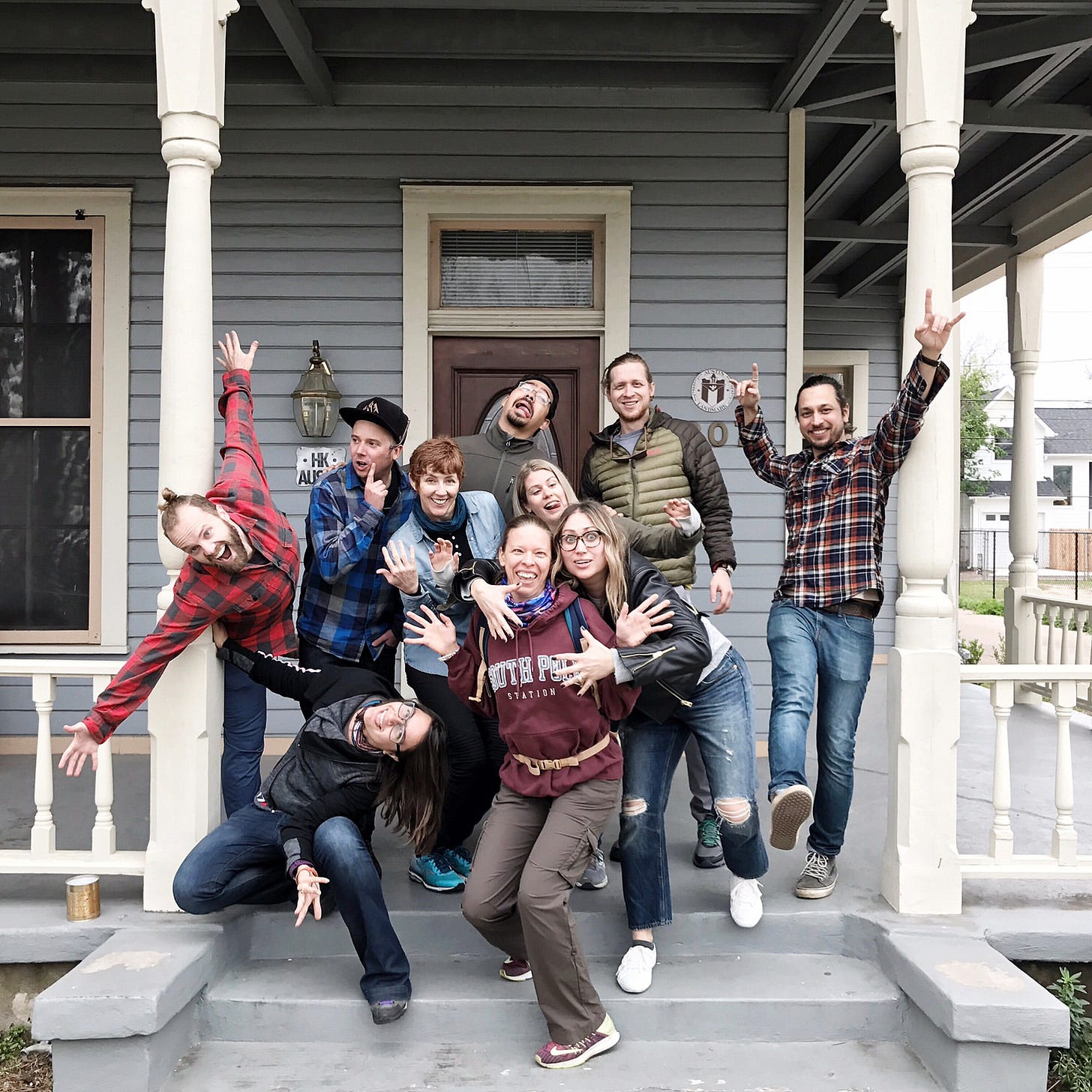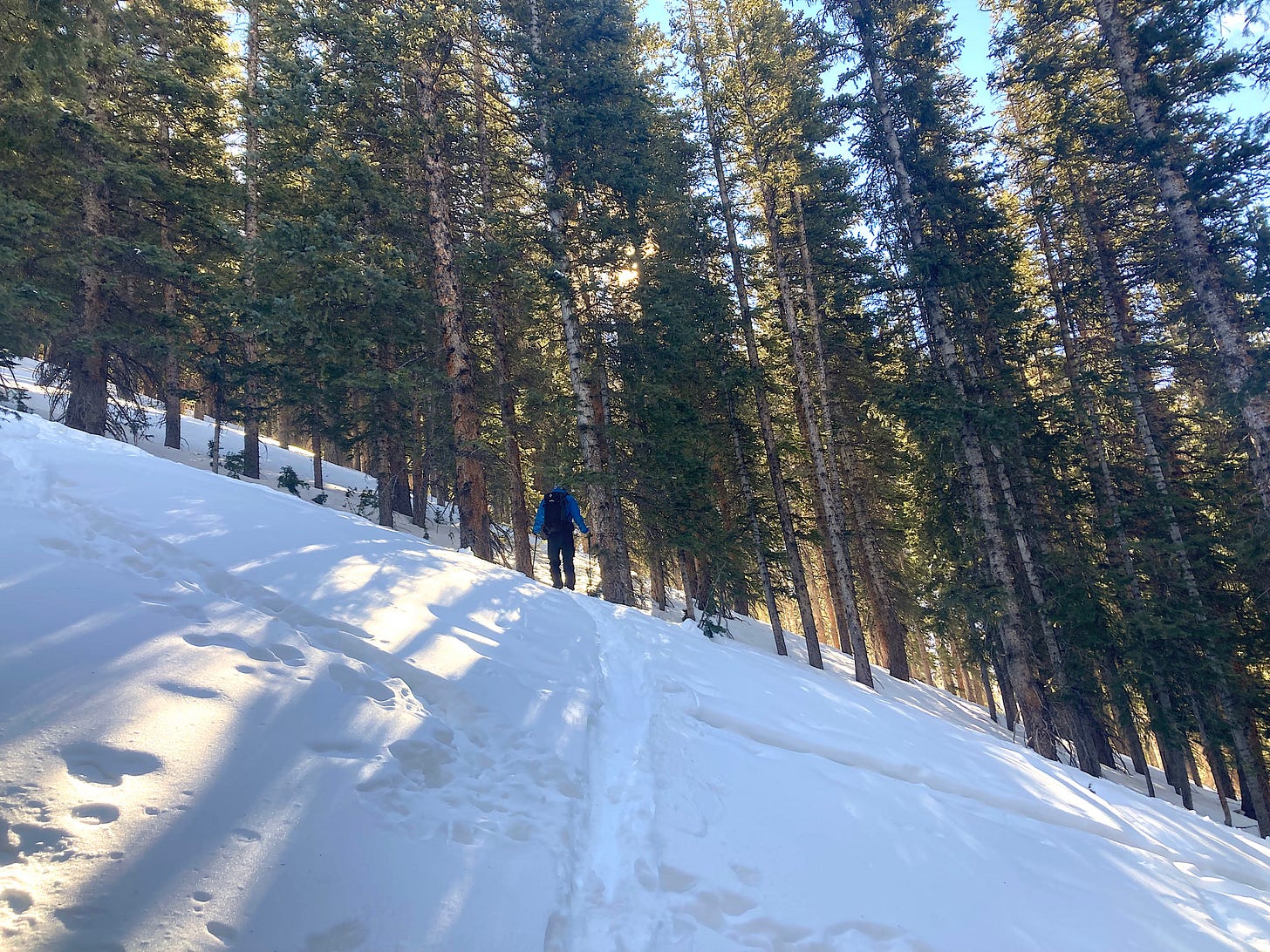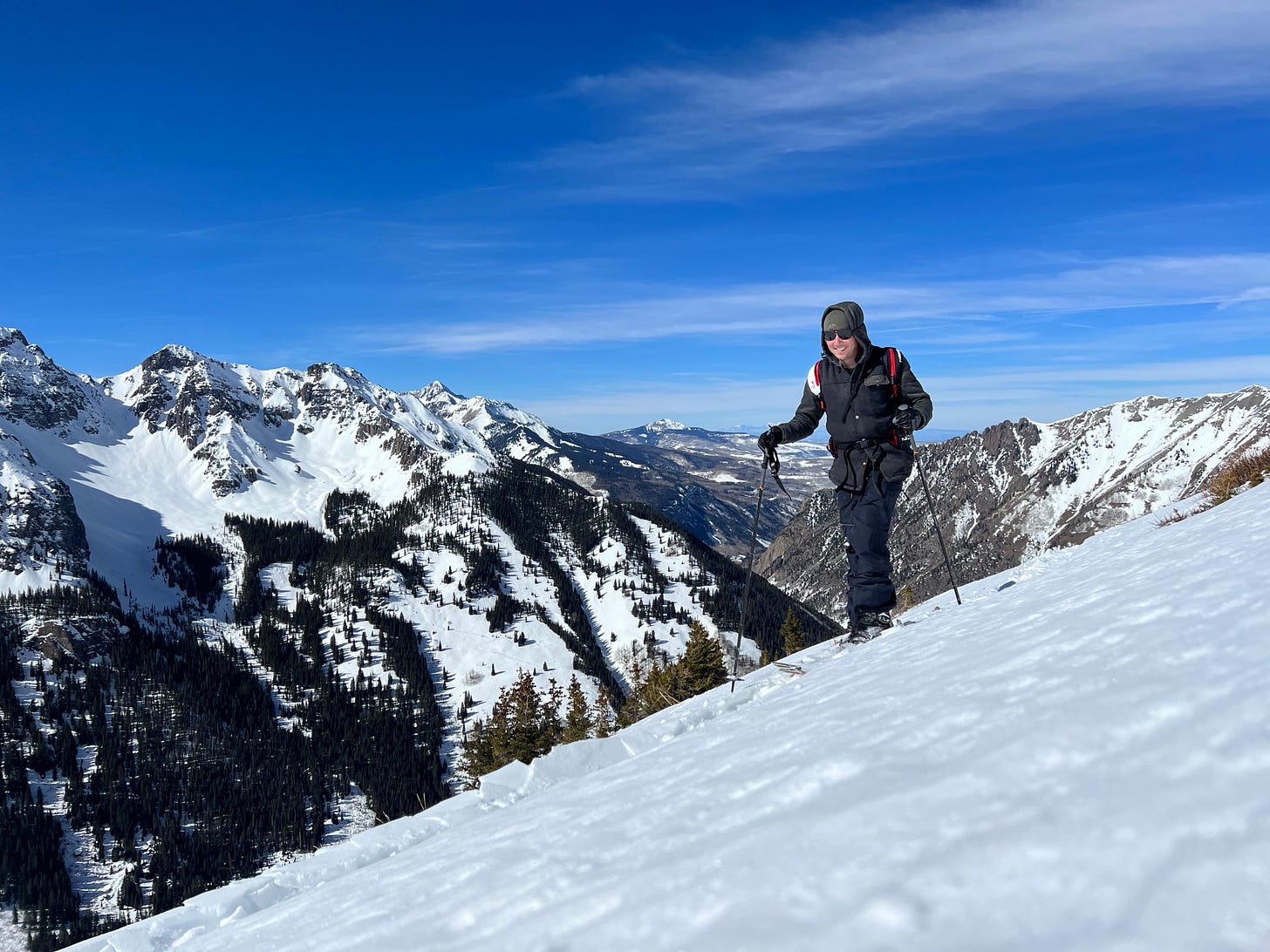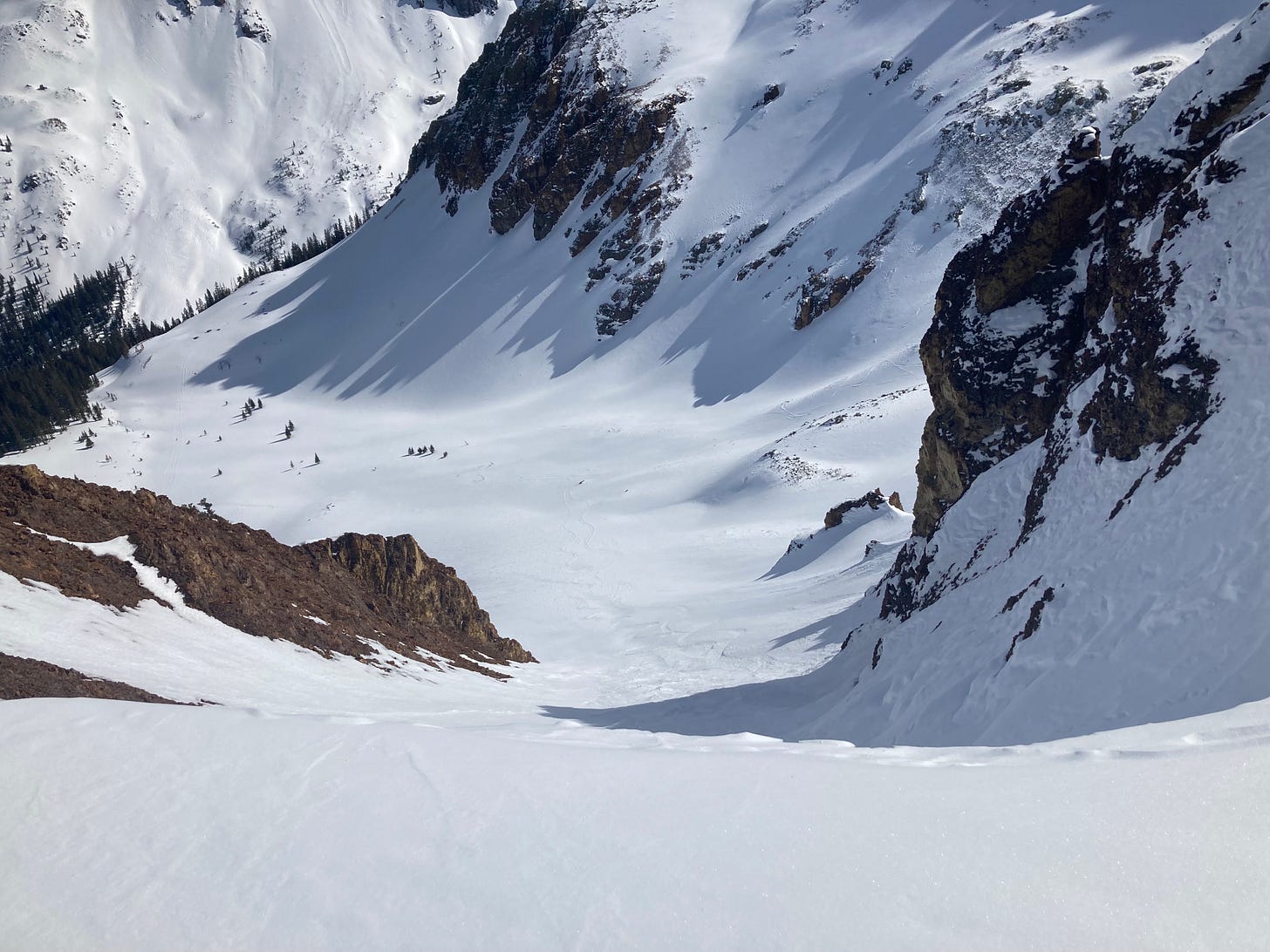Why I love coworking spaces and find them inspiring
Plus, the ACTUAL debut of Remote Focus
Hey reader,
This week’s essay is dedicated to Dylan Thuras, founder of the travel site Atlas Obscura. It’s very likely that without Dylan, I would never have started Mountain Remote.
Dylan appeared on my podcast, No Blackout Dates, last year, and said something that intrigued me — that he feels that platforms like Substack are the place to be for writers looking to do something cool with their work.
It was after chatting with Dylan that I first checked out Substack and began plotting the course for launching a newsletter of my own. Today’s dispatch is a testament to drawing inspiration from those with whom you come into contact.
Also, below the essay is some full-on mountain porn. Mountain Remote’s new section — Remote Focus — debuts today. This section is, and will continue to be, a photo gallery. The debut installment is from one of the most epic splitboard tours I’ve ever done, to the Nevada Zone above Ophir, Colorado, with 57Hours.
These photos were taken on February 10, 2022 — yesterday, for those reading this newsletter on its release day.
Community Shoutouts
Major props to Will for becoming Mountain Remote’s first paid subscriber! Thanks for your support buddy. You’re in line for some incredible paid-subscriber-only content over the course of this year.
Also, a warm welcome to the 5 new subscribers this week! Glad you’re here, and I hope I’m able to pass on to you some of the inspiration I’ve drawn from coworking and travel.
Now, let’s get sentimental.
Why I love coworking spaces and find them inspiring
The year was 1992. I was eight. Between heading to baseball practice, get-togethers with friends, and running errands with the fam, I spent a lot of time that year riding around Denver’s south suburbs in my mom’s minivan.
It was during these frequent shuttlings that I started spotting the posters hung up on street light poles, and the flyers on community service boards at the local King Soopers supermarket.
“Work From Home!” the flyers promised. “Guaranteed paycheck,” some even proclaimed.
Both of my parents worked, neither of them at home. I recall thinking, “How can you work at home, when you live there?”
I posed this question to my mom one day, undoubtedly en route to another baseball practice or after-school play date.
“Some people don’t want to drive to an office to go to work,” she said. “When you’re a busy adult, sometimes the idea of not going anywhere sounds really nice.”
This perplexed me. There was so much to see and do in the world. So many park playsets to conquer. Home was boring — it’s where you had to be when your parents said you couldn’t go anywhere else. Why on earth would anyone want to spend more time there?
Of course, most of these posters and flyers were promoting multi-level marketing schemes and the various other forms of “dream job” scams that existed before the invention of the spam email.
I had no comprehension of that, however, and I simply went on thinking these people were crazy for wanting to coop themselves up at home.
After more than a decade of remote work, I can now confirm that they were, indeed. You gotta get out of the house sometimes. For the veteran remote worker, there is no truer statement.
The best place to do this while remaining productive is a coworking space.
Cowork’n in Lakewood, Colorado, where I was a member for 1.5 years.
My introduction to coworking
I first set foot in Green Spaces coworking in Denver’s RiNo neighborhood in the summer of 2015. The magazine I edited then had rented a couple of desks for us to work at. We’d spent the prior four years working from coffee shops and from home, and I wasn’t very inclined to change.
I didn’t really get this coworking thing at first — all these people sitting there on their laptops, not really talking to each other, just kind of doing their own thing.
I’d thought the magazine had been doing just fine hosting editorial meetings at the Whole Foods coffee shop once a week. I also felt like the money spent on renting these desks would have been better spent if added to my measly contract.
It didn’t help that every time I walked into this place, I felt like I was trespassing. No one looked up, no one said hi . . . it was weird. I half expected someone to come up and ask me for my security clearance, then tell me to get lost.
My first days in there were awkward. I’d sit, trying to write or edit, but would mostly just gaze around the room trying to guess what everyone else was doing there.
I was under no obligation to report to Green Spaces every day — and so I didn’t. I made it down maybe twice a week, tops.
A few weeks in, I learned that the coworking space hosted weekly networking get-togethers and that a group of people met up out front once a week to go on a bike ride. Around this time, a colleague also pointed out to me that there was a kegerator in the kitchen — and that it was always stocked.
Learning this did wonders for reshaping my opinion of the place. I started showing up more often, started hanging around the kitchen come mid-afternoon, and chatting up people I didn’t know.
Nothing ever came of the contacts I made at Green Spaces, but for me, the coworking switch had been flipped. As a freelancer always on the hunt for the next contract, I began to see the benefit of having all these random people around, especially given that many of them owned online businesses. Online businesses frequently need copywriters — this much I knew.
I worked there for the remainder of the summer, and then in September, as happens to print publications in the age of the internet, the magazine folded. I was back home; playtime was over.
Discovering the greatest place in the world
Coworkers at Nomadic Matt’s hostel in Austin, Texas
Over the next two years, I had a couple of brief coworking experiences. One, in particular, proved quite fruitful. In February 2017, I attended a meet-up of remote workers in Austin, Texas. For two days, the organizers — Jason and Trav of Location Indie — rented a conference room at a coworking space just off East Cesar Chavez St.
While in Austin, I met a guy who ran an online language school. He said he was looking for a writer. I raised my hand. After putting together a proposal, I signed a contract as his Content Manager, a gig I’d go on to hold for over four years.
Not only that, but of the six other people in attendance, four hired me to write for them at least once. Within a month I’d made my money back on the trip. My affection for the magic that happens at coworking spaces was affirmed.
A few months later, that affection would blossom into a full-scale love affair.
I landed at Ngurah Rai International Airport in Bali, Indonesia, in late June of 2017. For one month, I would work at Outpost Coworking (which I declared in an earlier newsletter to be the greatest place on earth). I had also rented a room at an associated coliving space, both in the jungle village of Ubud.
Outpost proved to be a level of coworking that I had never seen before, and didn’t even know existed. Nearly every night, the space hosted an event — speakers, networking mixers, live music — and its member base showed up loyally.
This was because everyone there was a traveler, like me — a digital nomad, to adopt the common nomenclature. Traveling either alone or with a partner, we had no deeper social circle. The other coworking members were who we knew, and as such, people at the space became friends fast.
These after-work events often carried over into engaging dinner parties. On the weekends, we’d hop on our motorbikes and jet off to check out a hike or waterfall, or head down to Canggu to visit the beach.
The friendships formed during these endeavors frequently evolved into colleague relationships. Most everyone at Outpost was either a freelancer or running an online business. No matter the industry these businesses were in, the needs each had were commonplace — web designers and developers, copywriters, social media marketers.
Me being a writer, and also being a socially active person with a relatively outgoing personality, effectively put me in a consistent “right time, right place” situation. I met a friend there who became a long-time client.
Over the few months, I made enough money off this contract to cover not only my entire time in Bali, but the time I spent in Malaysia and Singapore afterward.
The relationships were full-circle. I myself hired a web developer I met at Outpost to build me a website for the book I had just written.
If I had simply arrived in Ubud and spent my time working by the pool and at cafes, I very likely wouldn’t have met those contacts. And I surely wouldn’t have made the lasting friendships.
The argument against coworking
Coming to grips with adding a $200-300 bill to your monthly expenses simply to have a place to sit and open your laptop isn’t an easy pill to swallow for some.
Paying hundreds of dollars per month to sit in a nearly empty room is not worth it. I’ve been in a couple spaces where this is essentially what’s on offer — and it’s no surprise when those coworking spaces shut down.
Good coworking spaces offset this by maintaining a strong focus on community. What makes coworking worth it are the connections you make there — through the happy hour events, group bike rides, yoga classes, and other activities that bring people together and break the ice.
Some remote workers aren’t into the social aspect, and for them, a coworking membership likely isn’t worth the cost. Others work remotely in order to spend more time with family or other outside-of-work priorities, and aren’t looking to network. The same goes for these workers.
Drawing inspiration from people doing awesome things
Coworking spaces are among the most inspiring places on Earth for creative types. Yes, there are the friendships to be made and the contracts to be signed, as mentioned above.
But one of the biggest perks comes simply from being around people doing awesome stuff. Most coworking members, as I noted earlier, either work for themselves or run a small business. These people are leaders, the type that takes charge of their lives and makes things happen.
There’s something to be said for the energy one gains from surrounding themself with people like this. Sure, I do plenty of work from home days, especially since the start of the pandemic. But I absolutely feel a sense of vibrance when I head into Grand Junction and post up at Alt Space, a coworking space downtown in the small but budding “tech hub” of Colorado’s western slope.
Listening to the stories of the other members, and shooting the breeze with them about my own projects, motivates me to keep going on this rewarding but often difficult path of self-employed contract work.
Mountain Remote News and Further Reading
For more on my affection for coworking, check out this point/counter-point piece I co-wrote with my colleague and podcast cohost, Eben Diskin — who himself is not a fan of coworking.
In the lede of this newsletter, I mentioned Atlas Obscura founder Dylan Thuras. Eben and I had the pleasure of interviewing Dylan on our podcast, No Blackout Dates, last year. Dylan is a brilliant mind with a ton of great ideas and critiques. Check out the interview on Spotify and Apple Podcasts.
Remote Focus
Context for this new section:
Remote Focus is a photo gallery intending to highlight mountain excursions in documentary format. Depending on how this inaugural edition impacts the newsletter and webpage load speed, I may include more or fewer photos in future editions.
One more quick note — I intentionally left off exact GPS coordinates as to where this excursion started and ended, as is customary in outdoor media. I encourage backcountry users to download GaiaGPS and onX.
Zone: Nevada Zone — Ophir, Colorado
Date: Feb. 10, 2022
Team: Tim Wenger, Bill Allen (guide) with Mountain Trips/57Hours
Itinerary:
8:00 A.M. - depart from the trailhead
12:30 P.M. - reach transition point on the backside of the peak
12:50 P.M. - drop into east-facing couloir leading into an open bowl, one valley east of skin track. The ride down took about 40 minutes, riding one at a time to designated stop points. We reached a snowed-over summer road that guided us back to Ophir. Bill was able to ski the entire road and trail back to the start point. As a splitboarder, I alternated between being strapped in, skating, and walking.
2:20 P.M. - arrive back at trailhead
Early in the skin up. Bill Allen in front, leading us through the forest.
As we climbed, the San Juan peaks began poking through the trees.
Credit: Bill Allen. The author approaching the transition point, happy to be done with a four-hour skin.
As Bill kept calling it, “The Playground.”
Nearing the peak, the jagged San Juans formed an amphitheatre style semi-circle around us.
Top of the couloir looking down . . . into the wide open bowl below. The cornice is tough to see at the bottom of the shot, but posed a formidable challenge on the entry. We entered to the far left of the shot.











I love coworking spaces because they foster creativity and collaboration in a way no other workspace does. The energy of being around diverse professionals with different projects inspires me to push boundaries, stay motivated, and seek new ideas. Coworking spaces are more than just offices; they're vibrant communities where innovation and inspiration flow freely.
https://www.matchoffice.it/affitto/uffici-di-servizio/bologna